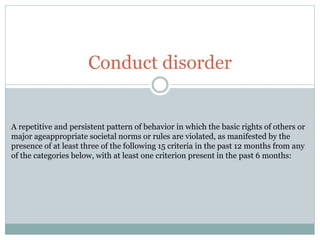
Conduct disorder.pptx
- 1. Conduct disorder A repetitive and persistent pattern of behavior in which the basic rights of others or major ageappropriate societal norms or rules are violated, as manifested by the presence of at least three of the following 15 criteria in the past 12 months from any of the categories below, with at least one criterion present in the past 6 months:
- 2. Diagnostic criteria Aggression to People and Animals 1. Often bullies, threatens, or intimidates others. 2. Often initiates physical fights. 3. Has used a weapon that can cause serious physical harm to others (e.g., a bat, brick, broken bottle, knife, gun). 4. Has been physically cruel to people. 5. Has been physically cruel to animals. 6. Has stolen while confronting a victim (e.g., mugging, purse snatching, extortion, armed robbery). 7. Has forced someone into sexual activity. Destruction of Property 8. Has deliberately engaged in fire setting with the intention of causing serious damage. 9. Has deliberately destroyed others’ property (other than by fire setting).
- 3. Deceitfulness or Theft 10. Has broken into someone else’s house, building, or car. 11. Often lies to obtain goods or favors or to avoid obligations (i.e., “cons” others). 12. Has stolen items of nontrivial value without confronting a victim (e.g., shoplifting, but without breaking and entering; forgery).
- 4. Serious Violations of Rules 13. Often stays out at night despite parental prohibitions, beginning before age 13 years. 14. Has run away from home overnight at least twice while living in the parental or parental surrogate home, or once without returning for a lengthy period. 15. Is often truant from school, beginning before age 13 years
- 5. B. The disturbance in behavior causes clinically significant impairment in social, academic, or occupational functioning. C. If the individual is age 18 years or older, criteria are not met for antisocial personality disorder Specify whether:Childhood-onset type, Adolescent- onset type, Unspecified onset Specify if:With limited prosocial emotions Lack of remorse or guilt, Callous—lack of empathy, Unconcerned about performance, Shallow or deficient affect Specify current severity: Mild, Moderate, Severe
- 6. How do these students do in school Teachers see these students as Uninterested, Unenthusiastic and Careless They have poor interpersonal skills Rejected by peers Poor social skills Likely to be left behind in grades Show lower achievement levels End school sooner than same-age peers
- 7. causes Exact causes unknown, but a combination of biological, genetic, environmental, psychological and social factors play a role Biological: defects or injuries to or improper nerve function in certain brain areas involved in regulating behavior, impulse control, and emotion. Comorbidity with ADHD, LD, depression or anxiety disorder and substance abuse Genetics: many have family members with mental illness including mood disorders, anxiety disorders, substance use disorders, and personality disorders suggesting hereditary influences
- 8. Environmental: dysfunctional family life, childhood abuse, and neglect, traumatic experiences, family history of substance abuse, inconsistent discipline Psychological: cognitive deficits like moral awareness, reflection and insight. Social: low socio economic status, and rejection from peers
- 9. Treatment Depends on age, severity, and ability to participate and tolerate specific therapies. Psychotherapy: aimed at teaching child to control and express anger in appropriate ways CBT to reshape thinking, improve problem solving skills, moral reasoning and for impulse control Social skills training through role play, modelling, shaping Guidance and counsellings Family therapy to improve family interaction and communication Parent management training teaches parents ways to positively alter child’s behavior at home. Medication: drugs to treat other associated distressing conditions such as ADHD or depressions
- 10. Antisocial personality disorder A. A pervasive pattern of disregard for and violation of the rights of others, occurring since age 15 years, as indicated by three (or more) of the following: 1. Failure to conform to social norms with respect to lawful behaviors, as indicated by repeatedly performing acts that are grounds for arrest. 2. Deceitfulness, as indicated by repeated lying, use of aliases, or conning others for personal profit or pleasure. 3. Impulsivity or failure to plan ahead. 4. Irritability and aggressiveness, as indicated by repeated physical fights or assaults. 5. Reckless disregard for safety of self or others. 6. Consistent irresponsibility, as indicated by repeated failure to sustain consistent work behavior or honor financial obligations. 7. Lack of remorse, as indicated by being indifferent to or rationalizing having hurt, mistreated, or stolen from another. B. The individual is at least age 18 years. C. There is evidence of conduct disorder with onset before age 15 years. D. The occurrence of antisocial behavior is not exclusively during the course of schizophrenia or bipolar disorder.